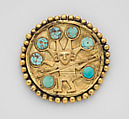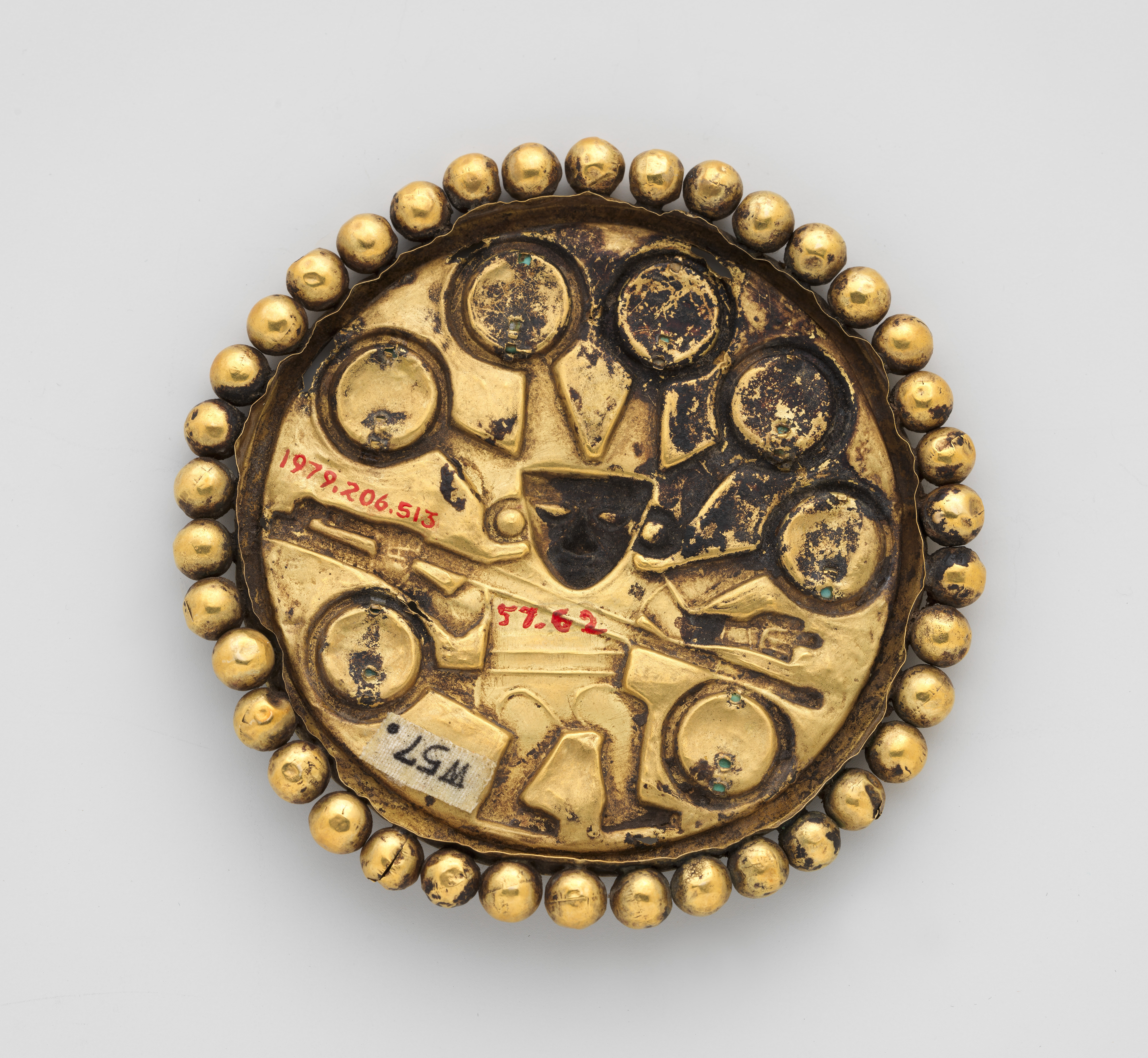Earflare Frontal
Not on view
This gold disk, once attached to a cylindrical shaft to create an ear ornament, was created by Moche metalsmiths on Peru’s North Coast between the 3rd and 7th centuries. The central figure launches a projectile—likely an articulated spear—with the aid of a throwing stick while he points with his other (right) hand. The figure wears a tunic and a loincloth, the latter indicated by lightly engraved parallel horizontal lines. Raylike extensions from the head and body terminate in circular forms with raised borders, now filled with turquoise inlays. The figure itself wears two ear ornaments that may have once also held inlays, now missing. Unlike the rest of the figure, which is rendered in low relief, the masklike face is rendered in high relief. The composition is encircled by a raised plain border, and the circumference of the ornament is embellished with 38 hollow spheres soldered to the rim.
This earflare frontal is one of a pair; its mate is presently in the collection of the National Museum of the American Indian, in Washington D.C. (16/1979; see Wardwell 1968-1969, no. 14). On the NMAI frontal the warrior holds the throwing stick and spear in his right hand and points with the left. The NMAI frontal now lacks inlays, although perforations in the circular forms suggest that they may have once been present. If the Met ornament was worn in the left ear and the NMAI one in the right, both figures would be seen as facing forward.
Often called earspools, the frontals of these ornaments were attached to long tubular shafts that would have been inserted through the stretched earlobes of a high-status individual, a conspicuous display of the wearer’s power and position. For many years, scholars believed that such ornaments were worn only by men; recent archaeological studies on Peru’s north coast, however, reveal that such ornaments were worn by certain high-status women as well.
References and further reading
Alva, Walter and Christopher B. Donnan. Royal Tombs of Sipán. Los Angeles: UCLA Fowler Museum of Cultural History, 1999.
Castillo, Luis Jaime. “Masters of the Universe: Moche Artists and Their Patrons.” In Golden Kingdoms: Luxury Arts in the Ancient Americas, edited by Joanne Pillsbury, Timothy Potts, and Kim N. Richter. Los Angeles: J. Paul Getty Museum, 2017, pp. 24-31.
Donnan, Christopher B. “Moche State Religion.” In New Perspectives on Moche Political Organization, edited by Jeffrey Quilter and Luis Jaime Castillo. Washington D.C.: Dumbarton Oaks Research Library and Collection, 2010, pp. 47-69.
Seo, Ji Mary. “How to Wear Body Ornaments from the Ancient Americas.” In #MetKids Blog. New York: The Metropolitan Museum of Art, 2018. https://www.metmuseum.org/blogs/metkids/2018/how-to-wear-body-ornaments-from-the-ancient-americas.
Wardwell, Alan. The Gold of Ancient America. Exh. cat. Boston: Museum of Fine Arts, 1968-1969, no. 14.
Wester La Torre, Carlos. Chornancap: Palacio de una gobernante y sacerdotisa de la cultura Lambayeque. Chiclayo: Ministerio de Cultura del Perú, 2016.
Due to rights restrictions, this image cannot be enlarged, viewed at full screen, or downloaded.
This artwork is meant to be viewed from right to left. Scroll left to view more.




